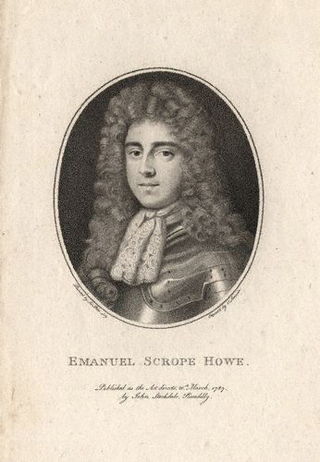
George Augustus Howe, 3rd Viscount Howe was a career officer and a brigadier general in the British Army. He was described by James Wolfe as "the best officer in the British Army". He was killed in the French and Indian War in a skirmish at Fort Ticonderoga the day before the Battle of Carillon, an ultimately disastrous attempt by the British to capture French-controlled Fort Carillon.

Earl Howe is a title that has been created twice in British history, for members of the Howe and Curzon-Howe family respectively. The first creation, in the Peerage of Great Britain, was in 1788 for Richard Howe, 4th Viscount Howe, but it became extinct upon his death in 1799. The second creation, in the Peerage of the United Kingdom, was in 1821 for Richard Curzon-Howe, 2nd Viscount Curzon, and it remains extant.

Lord Chedworth, Baron of Chedworth, in the County of Gloucester, was a title in the Peerage of Great Britain. It was created on 12 May 1741 for John Howe, who had earlier represented Wiltshire in Parliament. In 1736 he had succeeded to the estates of his cousin Sir Richard Howe, 2nd Baronet. He was succeeded in the barony by his eldest son, John, the second Baron. He served as Lord-Lieutenant of Gloucestershire. He was childless and on his death in 1762 the title passed to his younger brother, Henry, the third Baron. He was unmarried and was succeeded by his nephew, John, the fourth Baron. He was the eldest surviving son of Reverend the Honourable Thomas Howe, younger son of the first Baron. He never married and the title became extinct on his death in 1804.
Emanuel Scrope, 1st Earl of Sunderland, 11th Baron Scrope of Bolton was an English nobleman. He was Lord President of the King's Council in the North.
(Mary Sophia) Charlotte Howe, Viscountess Howe was a Hanover-born British courtier and politician.

Langar is an English village in the Vale of Belvoir, about four miles south of Bingham, in the Rushcliffe borough of Nottinghamshire. The civil parish of Langar cum Barnstone had a population of 980 at the 2011 Census. This was estimated at 1010 in 2019.

Lieutenant-General Emanuel Scrope Howe, of The Great Lodge, Alice Holt Forest, Hampshire, was an English diplomat, army officer, and Member of Parliament.

Scrope Howe, 1st Viscount Howe of Langar Hall, Nottinghamshire, was an English politician. He was the Member of Parliament (MP) for Nottinghamshire from 1673 to 1685 and January 1689 to 1691, and from 1710 to 1713.
Charles Howe (1661–1742) was an English devotional writer and courtier during the reigns of Charles II and James II of England and VII of Scotland.

Emanuel Scrope Howe, 2nd Viscount Howe of Langar Hall, Nottinghamshire, was a British politician and colonial administrator.
John Grubham Howe (1657–1722), commonly known as Jack Howe, was an English politician. Elected on numerous occasions as Member of Parliament, he made the transition from the Whig to the Tory faction.

John Grobham Howe (1625–1679) of Langar Hall, Nottinghamshire, was an English politician who sat in the House of Commons between 1659 and 1679.
Imogen Skirving was a British hotelier, who turned her family home Langar Hall into an award-winning country house hotel.
Geoffrey Neville Bayley Huskinson was an English first-class cricketer active 1922 who played for Nottinghamshire. He was born in Locarno; died in Hinton-Waldrist. His son was the cartoonist Geoffrey Huskinson, Jr., while his daughter was Imogen Skirving, a notable hotelier.
Geoffrey Mark Clement Huskinson was an English cartoonist and first-class cricketer. His cartoons found prominence from the mid-1970s, featuring in many exhibits, books and newspapers.

Sir George Smith, 1st Baronet (1714–1769) of Smith House, Angel Row, Nottingham and of Stoke Hall in the parish of East Stoke in Nottinghamshire, was a member of the Smith family of bankers, who established Smith's Bank in Nottingham in 1658. He was created a baronet "of East Stoke in the County of Nottingham", a title in the Baronetage of Great Britain, on 31 October 1757.

Langar cum Barnstone is a civil parish in the Rushcliffe borough, within the county of Nottinghamshire, England. The overall area had a population of 980 at the 2011 census. The parish lies near the county border with Leicestershire. It lies 120 miles north of London, 4 miles south east of Bingham and 12 miles south east from the city of Nottingham.

The Howe baronetcy, of Compton in the County of Gloucester, was created in the Baronetage of England on 22 September 1660 for John Howe, Member of Parliament for Gloucestershire in 1654–1655 and 1656–1658. His elder son Richard, the second baronet, was also an MP, as was his younger son John Grobham Howe. Sir Richard Grobham Howe, the third baronet, was MP for Tamworth, Cirencester and Wiltshire. Sir Emanuel Scrope Howe, 4th Baronet became the 2nd Viscount Howe on the death of his father in 1713 and the baronetcy which he inherited in 1730 was merged with his viscountcy.

Francis Wright JP DL, was a British industrialist and philanthropist.











